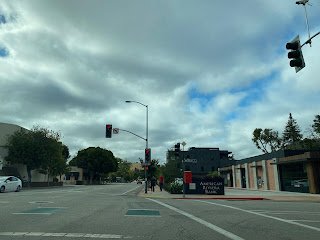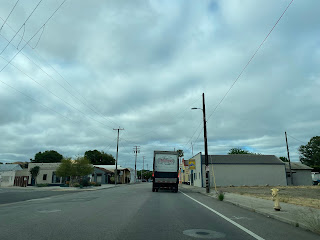Originally US Route 101 upon descending Cuesta Pass southbound entered the City of San Luis Obispo via Monterey Street. From Monterey Street US Route 101 utilized Santa Rosa Street and Higuera Street southbound through downtown San Luis Obispo. Upon departing downtown San Luis Obispo US Route 101 would have stayed on Higuera Street southward towards Pismo Beach and Arroyo Grande. Notably; beginning in 1934 US Route 101 picked up California State Route 1 at the intersection of Monterey Street/Santa Rosa Street where the two would multiplex to Pismo Beach. Pictured below is the 1935 Division of Highways Map of San Luis Obispo County depicting the original alignments of US Route 101 and California State Route 1 in the City of San Luis Obispo.
Part 1; the history of US Route 1 and California State Route 1 in San Luis Obispo
San Luis Obispo lies at the bottom of the Cuesta Pass (also known as the Cuesta Grade) which has made it favored corridor of travel for centuries. Cuesta Pass was a long known way through Santa Lucia Range between the coastal areas near San Luis Obispo north into the Salinas River Valley by the local Chumash Tribes of Southern California. During September of 1769 Portola Expedition of Las Californias the Spanish actually missed Cuesta Pass and opted to attempt to travel up the coast through the Big Sur Region. The Portola Expedition ultimately found the terrain impassable at Ragged Point and traveled northeast up San Carpoforo Creek to San Antonio Valley near modern day Jolon. The Spanish didn't discover Cuesta Pass until it was located during a 1774 expedition led by Juan Bautista de Anza. The route over Cuesta Pass was solidified by the Second Expedition by Juan Bautista de Anza in 1775-1776. The route of the expeditions led by Juan Bautista de Anza solidified what would become the route of El Camino Real (The Royal Road).
The route of El Camino Real was intended to solidify a path of travel between the Catholic Missions of Las Californias. In 1804 Alta California was formed out of the larger Las Californias. El Camino Real would ultimately connect 21 Catholic Missions of Alta California ranging approximately 600 miles spanning from Mission San Diego de Alcala in San Diego north to Mission San Francisco Solano in Sonoma. The Missions of El Camino Real were established from 1769 through 1823. In the case of Mission San Francisco Solano it was established two years after Mexico had won it's independence from Spain in 1821. Each Mission was meant to be approximately 30 miles apart from each other which would require a single day of travel by horseback.Mission San Luis Obispo de Tolosa was the fifth to be established along the path of El Camino Real in 1772. Following the expeditions of Juan Bautista de Anza the route north from Mission San Luis Obispo de Tolosa was known as the "Padre Trail.". Following the secularization of Mission San Luis Obispo de Tolosa (as well as the other Missions) in August of 1833 the land holdings were split off into Ranchos. Despite El Camino Real functionally no longer existing the route up the Padre Trail through Cuesta Pass remained popular. The City of San Luis Obispo quickly grew around the former land holdings of Mission San Luis Obispo de Tolosa. Alta California was annexed by the United States in early 1848 and San Luis Opispo became the first incorporated City in the newly formed San Luis Obispo County in 1850. Cuesta Pass and the Padre Trail from San Luis Obispo north to Rancho Santa Margarita are clearly seen on the 1857 Britton & Rey Road Map of California.
In 1904 the American El Camino Real Association was formed with the goal to mark a modern highway that corresponded to the historical route between the Spanish Missions. Ultimately the path of American El Camino Real was to be marked by the signature bells the corridor is known by today. The first bell marking the American El Camino Real was placed in 1906 and it is estimated by 1915 that there may have been anywhere from 158 to 400 placed in-field. San Luis Obispo, Cuesta Pass and the Mountain Road being along the main highway at the time was signed as part of the American El Camino Real. The American El Camino Real was one of the earliest analogs of what would become the signed Auto Trails. The background of the American El Camino Real is covered extensively on CAhighways.org.
CAhighyways.org on the American El Camino Real
The era of State Highway Maintenance through San Luis Obispo would begin with the 1909 First State Highway Bond Act which was approved by voters in 1910. One of the highways approved through the 1909 First State Highway Bond Act was a 481.8 mile highway originating at the City Limits of San Francisco which terminated in San Diego. This highway would ultimately come to be known in time as Legislative Route Number 2 ("LRN 2"). In 1913 the Pacific Highway was plotted as a major Auto Trail which had San Luis Obispo along it's planned route.
The 1920 Rand McNally Highway Map of California shows El Camino Real and the Pacific Highway following LRN 2 through San Luis Obispo.
The 1923 Pacific Southwest Trust & Savings Map of San Luis Obispo shows LRN 2 utilizing; Monterey Street, Chorro Street and Higuera Street headed southbound through the City. Major highways are shown departing LRN 2 at Broad Street southward and Santa Rosa Street northward. It is unclear when through route of LRN 2 shifted from Chorro Street to Santa Rosa Street.
The 1924 Rand McNally Map of California shows the California Banff Bee-Line Highway co-signed with the Pacific Highway on LRN 2 through San Luis Obispo.
The July/August 1930 California Highways & Public Works lists an extension of LRN 56 from Cambria south to San Luis Obispo as a recommended State Highway adoption.
The August 1931 California Highways & Public Works announced the extension of LRN 56 from Cambria southward to San Luis Obispo. According to CAhighways.org the Cambria-San Luis Obispo extension of LRN 56 was added to the State Highway System as part of 1931 Legislative Chapter 82. LRN 56 from it's 1931 extension appears to always have entered the City of San Luis Obispo via Santa Rosa Street.
In 1933 LRN 147 was added to the State Highway System as a route between; "LRN 2 (US 101) near Arroyo Grande and LRN 2 (US 101/CA 1) in San Luis Obispo." LRN 147 northbound entered San Luis Obispo via Broad Street and terminated at US 101/CA 1/LRN 2 at Higuera Street.
As noted in the intro the 1935 Division of Highways Map of San Luis Obispo County depicts the original alignments of US 101 and CA 1 in the City of San Luis Obispo.
The January/February 1948 California Highways & Public Works announced a new four lane alignment of US 101/CA 1/LRN 2 from Miles Station 6.6 miles north to Marsh Street in San Luis Obispo had recently opened to traffic. This new segment of four lane US 101/CA 1/LRN 2 realigned both highways northbound onto a new alignment which entered downtown San Luis Obispo via Marsh Street. Northbound US 101/CA 1/LRN 2 multiplexed on Marsh Street onto Santa Rosa Street towards the split at Monterey Street. At Monterey Street US 101/LRN 2 departed towards Cuesta Pass whereas CA 1/LRN 56 stayed on Santa Rosa Street towards Morro Bay. The shift of US 101/CA 1/LRN 2 saw LRN 147 truncated to a new terminus at the intersection of Broad Street and Marsh Street.
Former US 101/CA 1 southbound would have originally followed Higuera Street through downtown San Luis Obispo. Former US 101/CA 1 southbound on Higuera Street intersect the 1948-1954 alignment at the Marsh Street intersection which now also is a onramp to modern US 101.

































































Comments
Camron
https://www.sanluisobispo.com/news/local/news-columns-blogs/photos-from-the-vault/article289976154.html